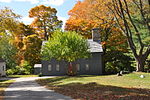WPRO-FM
1948 establishments in Rhode IslandContemporary hit radio stations in the United StatesCumulus Media radio stationsHD Radio stationsRadio stations established in 1948 ... and 1 more
Radio stations in Providence, Rhode Island
WPRO-FM (92.3 MHz "92 PRO-FM") is a commercial top 40 (CHR) radio station in Providence, Rhode Island, United States, owned by Cumulus Media. The studios and offices are located in the Brine Broadcasting Center on Wampanoag Trail on the East Providence–Barrington line. The transmitter is located on Neuticonacanut Hill in Johnston, Rhode Island. WPRO-FM is unique in the Providence media market in keeping the same call sign since its sign-on in 1948; and the same format, top 40, since 1974.
Excerpt from the Wikipedia article WPRO-FM (License: CC BY-SA 3.0, Authors).WPRO-FM
Ipswich Street,
Geographical coordinates (GPS) Address Nearby Places Show on map
Geographical coordinates (GPS)
| Latitude | Longitude |
|---|---|
| N 41.804722222222 ° | E -71.472777777778 ° |
Address
WPRO-FM (Providence)
Ipswich Street
02909
Rhode Island, United States
Open on Google Maps








